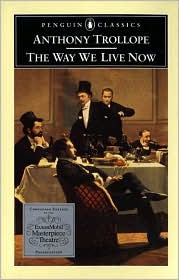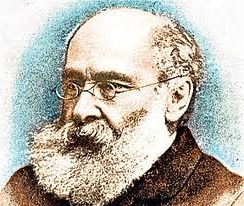“You need a special kind of man who understands the way we live now to lead you into that new world of peace and prosperity.”
Often conside red Trollope’s greatest novel, this satire of British life, written in 1875, leaves no aspect of society unexamined. Through his large cast of characters, who represent many levels of society, Trollope examines the hypocrisies of class, at the same time that he often develops sympathy for these characters who are sometimes caught in crises not of their own making. Filling the novel with realistic details and providing vivid pictures of the various settings in which the characters find themselves, Trollope also creates a series of exceptionally vibrant characters who give life to this long and sometimes cynical portrait of those who move the country.
red Trollope’s greatest novel, this satire of British life, written in 1875, leaves no aspect of society unexamined. Through his large cast of characters, who represent many levels of society, Trollope examines the hypocrisies of class, at the same time that he often develops sympathy for these characters who are sometimes caught in crises not of their own making. Filling the novel with realistic details and providing vivid pictures of the various settings in which the characters find themselves, Trollope also creates a series of exceptionally vibrant characters who give life to this long and sometimes cynical portrait of those who move the country.
Lady Carbury, her innocent daughter Henrietta (Hetta), and her attractive but irresponsible son Felix are the family around which much of the action rotates. They are always in need of money and Lady Carbury writes pap novels to support the family (and Felix’s drinking and gambling). In contrast to the Carburys, and just as important to the plot, are the Melmottes. Augustus Melmotte, who has come from Vienna under a cloud of financial suspicions, has acquired a huge estate for himself, his foreign wife, and his marriageable daughter. Boorish, but determined to become a leader of society, Melmotte provides moments of humor for the reader, though he is scorned by an aristocracy which is nevertheless beholden to him for his investments.

When Melmotte becomes the major investor in a plan to build a railway from California to Mexico, Paul Montague, a young businessman who has been working on building a railroad in America, arrives in town. A ward of Roger Carbury, cousin of Felix and Hetta, he soon finds himself in love with Hetta–and in competition with Roger for her hand. Felix courts the Melmottes’ daughter for her fortune, and she falls in love with him while he dallies with a local domestic worker. Investors dash to buy shares in the Mexican railway, with their investments ending in the sticky hands of Melmotte, who has bigger plans.
Often addressing the reader directly, Trollope fills the novel with action and subplots which illustrate a wide variety of themes, often depicting his characters satirically to illustrate the social, political, and financial ills of the day. Ahead of his time for his depiction of the lively, intelligent woman whose role is defined (and limited) by her social and financial position, Trollope creates a number of resourceful women–and a number who are willing to do almost anything to marry a wealthy man. As is customary in Victorian novels, the good are rewarded here, and the evil are punished, but Trollope’s characters, unlike those by Dickens, for example, usually control their own destinies. Broad in scope, thoughtful in construction, complete in its depiction of 1870s’ England, filled with wonderful characters, and absolutely engrossing to read, The Way We Live Now is one of the great novels of the nineteenth century.
Notes: The author’s photo is from http://www.telegraph.co.uk
Also reviewed here: Six other Trollope novels. See Authors tab at top of the page.
